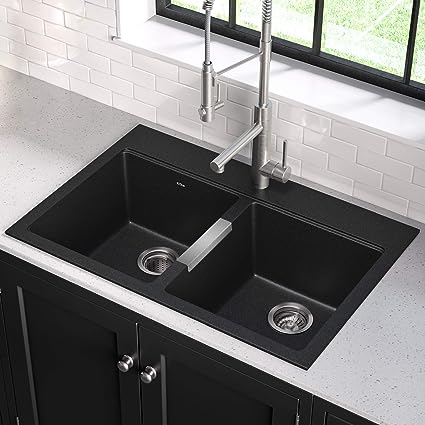Selecting the right drain configuration for your kitchen sink is a decision that goes beyond mere aesthetics – it can significantly impact your daily kitchen activities and even influence your cleaning routines. The proper flow of water, effective debris removal, and the prevention of potential clogs are all dependent on this seemingly minor aspect of your sink’s design.
Moreover, the choice between a center drain and an offset drain isn’t just about practicality; it’s also a design consideration that can harmonize with your kitchen layout and enhance the visual appeal of your culinary space. The functionality and convenience of your kitchen are intricately tied to the small yet crucial elements, and the selection of the appropriate drain configuration stands as a testament to this fact.
As we delve into the discussion of center vs. offset drain kitchen sinks, keep in mind the significant impact that this decision can have on your daily routines and the overall ambiance of your kitchen environment. By understanding the nuances of these options, you’ll be better equipped to make an informed choice that aligns with your unique needs and elevates your kitchen experience to new heights.

Featuring a DROP-IN design with a robust mounting deck, this sink effortlessly fits into various kitchen counters, making it an ideal replacement option. The UNDERMOUNT design ensures a smooth countertop-to-sink transition, allowing you to conveniently wipe spills straight into the sink without any exposed rim that might trap food particles.
Center Drain Kitchen Sink
A center drain kitchen sink is designed with the drainage hole positioned at the center of the sink’s basin. This means that when you place dishes, utensils, or other items in the sink, the water will naturally flow towards the center and then down the drain. Center drain sinks often have a symmetrical and balanced appearance, making them a popular choice for kitchen designs that emphasize aesthetics and a clean, uniform look.

Positioned at the center, the drain enables unimpeded water flow, ensuring effective drainage and minimizing the likelihood of water accumulation in the sink. Kitchen sink from @ renovating9tg
Pros:
- Symmetrical Appearance: Center drain sinks often provide a balanced and symmetrical look, which can enhance the overall aesthetics of your kitchen. They tend to be visually pleasing and can complement various kitchen designs.
- Drainage Efficiency: With the drain placed in the center, water naturally flows down the drain without any obstacles, ensuring efficient drainage and reducing the chances of water pooling in the sink.
- Space for Accessories: The absence of a drain on one side of the sink can provide more space for accessories like dish racks, cutting boards, and other kitchen tools, as these items won’t interfere with the central drain.
Cons:
- Limited Space for Large Items: Center drain sinks may have limited space for washing large pots, pans, and baking sheets. These items can sometimes block the drain, making it a bit more challenging to manage water flow and drainage.
- Awkward Placement of Plumbing: The central drain location can sometimes result in plumbing lines taking up space under the sink, potentially limiting storage options or making it less convenient for installation.
- Potentially Higher Installation Costs: Depending on your kitchen’s plumbing setup, installing a center drain sink might require more complex plumbing work, leading to slightly higher installation costs compared to offset drain sinks.
Offset Drain Kitchen Sink
An offset drain kitchen sink, on the other hand, has its drainage hole positioned towards one side of the sink’s basin, rather than in the center. This design is practical for a few reasons. First, it can provide more usable space in the sink because the plumbing components are not directly under the center of the basin. Second, when you’re washing larger pots and pans, the offset drain allows you to lay them flat in the sink without blocking the drain, which can be more convenient.

An off-center drain in a kitchen sink can offer increased functional area within the basin, as the plumbing components are positioned away from the central space. Kitchen from @ renovatingnumber174
Pros:
- More Usable Space: The offset drain design allows for more usable space within the sink. Since the plumbing components are located to one side, you have more room on the other side for washing dishes, preparing food, or other kitchen tasks.
- Accommodates Larger Items: One of the main benefits of an offset drain sink is that it can easily accommodate larger pots, pans, and baking sheets without obstructing the drain. This can make cleaning and washing larger cookware much more convenient.
- Easier Installation: The plumbing configuration for an offset drain sink can often be simpler and more straightforward than for a center drain sink, potentially leading to easier and less expensive installation.
Cons:
- Asymmetrical Look: Offset drain sinks may have a less symmetrical appearance compared to center drain sinks, which might not align with certain kitchen design aesthetics.
- Potential for Water Pooling: Depending on the sink’s design and drainage slope, there’s a possibility that water may not always drain as efficiently as in a center drain sink. This could potentially lead to water pooling in certain areas of the sink.
- Less Space for Accessories: Since the plumbing components take up space under the sink on one side, you might have less room for accessories like dish racks or cutting boards on that side.

One drawback of an offset drain kitchen sink is the potential for slightly less effective drainage compared to a center drain sink. This may result in occasional water accumulation in specific regions of the sink. Adorable kitchen sink from @ homeonanashvillehill
The choice between a center drain and an offset drain sink often comes down to personal preference and how you plan to use your sink. Some people prioritize the aesthetics of a center drain sink, while others appreciate the functionality and extra space provided by an offset drain sink, especially for larger cooking and cleaning tasks. Consider your kitchen layout, workflow, and design preferences when deciding which type of sink is best for you.










